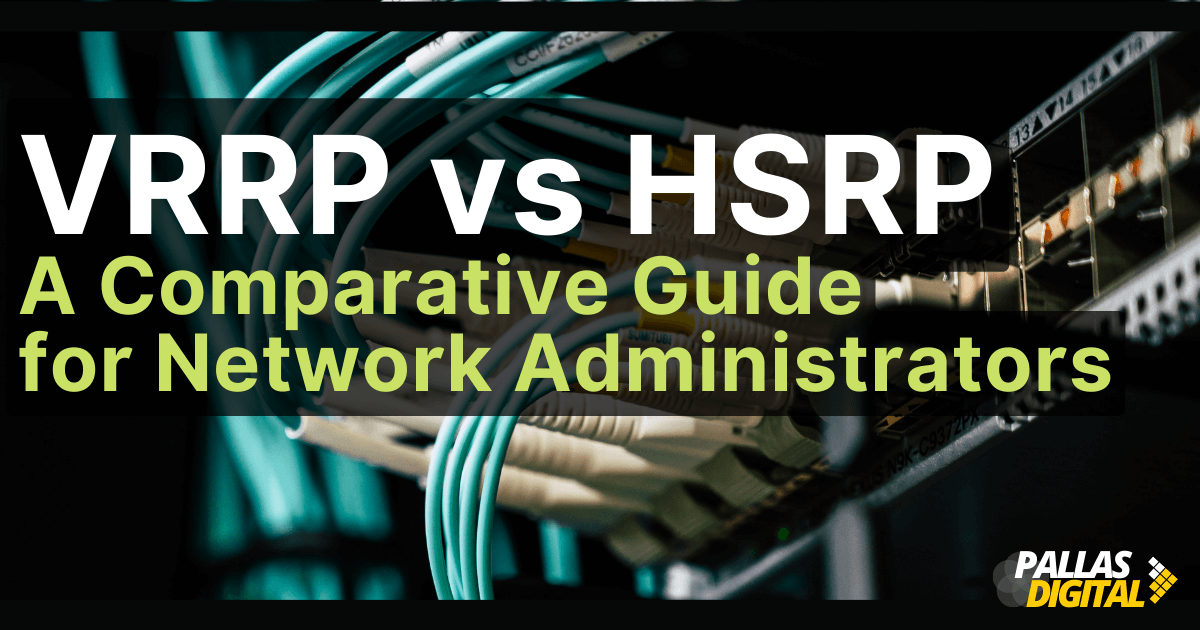For network administrators, ensuring network availability is paramount. First hop redundancy protocols (FHRPs) are instrumental in this endeavor.
Among the multiple options, VRRP and HSRP are prominent. This article explains both protocols, compare VRRP vs HSRP and spotlighting their merits and demerits.
Table of Contents
Deciphering First Hop Redundancy Protocols (FHRPs)
In expansive networks, the failure of a single router can be catastrophic. FHRPs, which are mechanisms to ensure that network traffic can continue even if the primary gateway (or router) fails, come to the rescue. They enable a seamless transition between routers during failures, minimizing potential downtime.
VRRP (Virtual Router Redundancy Protocol) Demystified
VRRP in Action
VRRP facilitates a group of routers to establish a virtual router with a specific IP and MAC address. One router serves as the master, managing traffic, while the others are on standby. If the master router fails, a standby router steps in, guaranteeing continuous network traffic.
VRRP’s Monitoring Mechanism
VRRP’s monitoring involves periodic “hello” messages exchanged between the master and standby routers. A halt in these messages signals potential issues.
Additionally, VRRP can deploy ICMP (Internet Control Message Protocol) echo requests, a network diagnostic tool, to ascertain the master router’s status.
VRRP’s Failover Mechanism
Upon detecting a failure, VRRP initiates a failover, designating a standby router as the new master. This transition updates the ARP (Address Resolution Protocol – a protocol used to map IP addresses to MAC addresses) cache, ensuring other network devices recognize the new master router.
Advantages of VRRP
- Standardization: VRRP’s status as a standards-based protocol ensures broad compatibility across diverse network architectures.
- Multiple VRRP Groups: While VRRP doesn’t provide traditional load balancing, using multiple VRRP groups can distribute different traffic flows across different master routers.
- Multiple Virtual Routers: VRRP’s ability to support several virtual routers amplifies network resilience.
Limitations of VRRP
- Scalability: For colossal networks demanding extensive scalability, VRRP might fall short.
- Routing Challenges: While VRRP is versatile, certain network configurations, like those with asymmetric routing, might present challenges. This isn’t unique to VRRP; other FHRPs can also face issues in such scenarios.
HSRP (Hot Standby Router Protocol) Unraveled
HSRP at Work
HSRP, birthed by Cisco, empowers routers to form a virtual entity. One router functions as the active router, directing traffic, while others remain on standby. If the active router fails, a standby router seamlessly assumes control.
HSRP’s Monitoring Mechanism
Like VRRP, HSRP utilizes “hello” messages to monitor the active router’s status. Additionally, ICMP echo requests can be employed to verify the active router’s availability.
HSRP’s Failover Process
HSRP’s failover mirrors VRRP’s. The standby router assumes the active role, updating the ARP cache to reflect the change.
HSRP’s Edge over VRRP
- Cisco Compatibility: As a Cisco creation, HSRP is tailored for Cisco devices.
- Configurability: HSRP offers extensive customization options, granting network administrators superior control.
HSRP’s Drawbacks
- IPv4 Limitation: While older HSRP versions were IPv4-exclusive, HSRP version 2 supports IPv6.
- Cisco Exclusivity: HSRP’s compatibility is primarily with Cisco devices.
- Multicast Dependency: HSRP’s reliance on multicast addresses might be problematic in specific scenarios or older network configurations, though it’s generally not an issue in most modern networks.
VRRP vs HSRP: The Verdict
Commonalities
Both protocols prioritize network continuity, employing virtual IP and MAC addresses for transparent failovers. They also embrace the concept of router priority and preemption, granting administrators control over failover dynamics.
Distinctions
HSRP’s Cisco-centric design is its standout feature. Conversely, VRRP’s open-standard nature and ability to use multiple VRRP groups for different traffic flows make it versatile.
Making the Informed Choice
When oscillating between VRRP and HSRP, consider your network’s equipment type, required control level, and routing needs. By evaluating these parameters, you can select the protocol that aligns best with your network’s demands.

